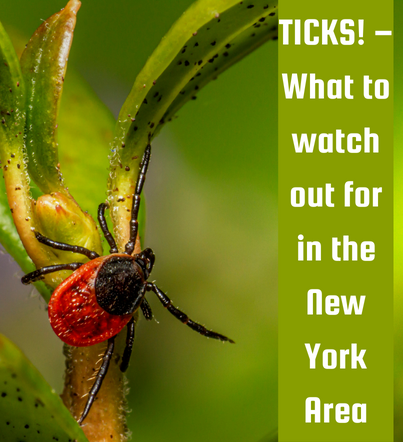Ticks are common in the New York area and can transmit diseases that can be serious or even fatal if left untreated. Lyme disease is the most well-known tick-borne disease, but several others can cause serious illness. Let's explore what ticks are, the diseases they can transmit in the New York area, and methods for tick control to prevent tick bites.
What is a Tick?
Ticks are tiny, parasitic arachnids that feed on the blood of animals. The most common tick species in the New York area are the black-legged, deer, and dog ticks. Black-legged ticks are often associated with transmitting Lyme disease, while dog ticks can transmit Rocky Mountain spotted fever and other diseases.
Ticks are typically found in wooded areas, tall grasses, and shrubs. They can also be found in urban areas, particularly parks and hiking trails. Ticks have a unique feeding mechanism. They use their mouthparts to cut into the skin of their host and then attach themselves with barbs. Once connected, ticks can feed on their host's blood for days or weeks. During this time, they can transmit diseases to their host.
Tick Control Information
The best way to prevent tick-borne diseases in New York is to avoid tick bites. Several methods for tick control can reduce the risk of tick bites:
- Wear protective clothing: When spending time in wooded areas or tall grasses, wear long-sleeved shirts, long pants, and closed-toe shoes. Tucking your pants into your socks can also help prevent ticks from crawling up your legs. Light-colored clothing can also make it easier to spot ticks.
- Use insect repellent: Apply insect repellent containing DEET, picaridin, or other EPA-approved repellents to exposed skin and clothing. Be sure to follow the instructions on the label.
- Check for ticks: After spending time outdoors, check yourself, your children, and your pets for ticks. Pay close attention to areas where ticks are known to hide, such as behind the knees, in the groin area, and in the armpits.
- Treat your yard: Keep your lawn mowed and remove any leaf litter or other debris where ticks may hide. You can also use organic tick control methods, such as spraying your yard with essential oils or tick tubes containing treated cotton that mice can use to build their nests.
Tick Diseases
In the New York area, the most common tick-borne disease is Lyme disease. Other prevalent tick-borne diseases include anaplasmosis, babesiosis, and the Powassan virus. Symptoms of these diseases can vary, but they often include fever, headache, fatigue, and muscle aches. These diseases can sometimes lead to more severe complications, such as meningitis or encephalitis.
Lyme Disease
The most prevalent vector-borne illness in the US is Lyme disease. Infected black-legged ticks bite humans to spread the disease. Fever, headaches, exhaustion, and an erythema migrans-like skin rash are typical symptoms. Infection can spread to joints, the heart, and the neurological system if not treated. Lyme disease is identified based on symptoms, physical signs (such as a rash), and the potential for tick exposure. If done appropriately and using procedures that have been established, laboratory testing is beneficial. With a few weeks of medicines, the majority of cases of Lyme disease can be successfully treated.
Anaplasma Phagocytophilum
The bacteria Anaplasma phagocytophilum is the cause of the tick-borne disease anaplasmosis. The primary way that people get infected with this is through tick bites. The black-legged tick (Ixodes scapularis) in the Northeast and Midwestern United States and the western black-legged tick (Ixodes pacificus) in the West Coast are the carriers of the bacteria in the United States.
A. phagocytophilum will spread through blood transfusions. Anaplasmosis signs and symptoms often appear one to two weeks after the tick bite that caused the infection. Most tick bites are painless; many victims do not remember being bitten. If you feel unwell after being bitten by a tick, being in densely forested areas, or being in the woods, where ticks are likely to live, see your healthcare provider.
Powassan Virus
Powassan viral disease (POW) is an uncommon but frequently severe illness brought on by a virus transmitted through infected ticks' bite. The virus cannot be passed from one person to another directly. The town of Powassan, Ontario, where the virus was initially found in 1958, bears its name. It can result in symptoms ranging from minor flu-like signs to encephalitis, an inflammation of the brain, which can be fatal. POW viral sickness affects 1 to 2 people in New York State annually. The easiest way to avoid contracting the POW virus disease is to take the necessary steps to limit tick exposure.
Many POW virus victims do not experience any symptoms at all. For those who do, symptoms often show 1 to 4 weeks after being bitten by an infected tick. Fever, headache, nausea, weakness, confusion, lack of coordination, difficulty speaking, and seizures are some of the symptoms that might occur. Faster onset symptoms of severe infections include headache, fever, disorientation, tremors, seizures, paralysis, coma, or even death. The POW virus can bring both meningitis and encephalitis, which are inflammations of the membranes that protect the brain and spinal cord. Most survivors experience persistent neurological symptoms, including memory loss, recurring headaches, and muscular atrophy. 10% of instances of POW virus encephalitis result in death.
Wrapping Up
Ticks can pose a severe health risk in the New York area, but there are steps you can take to protect yourself and your loved ones. If you're looking for effective tick control solutions, consider checking out Emerald Tree Care. With our unique approach to tick treatment, we offer a Free Consultation where our certified arborist will come to your home at no cost.
Our Organic Application is also safe for humans and pets, protecting your family from ticks and harmful chemicals. And with our Emerald Guarantee, you can rest easy knowing that we stand behind our work. Don't let ticks take over your yard - contact Emerald Tree Care today to learn more about our tick control services.










